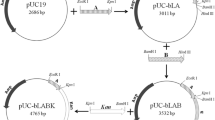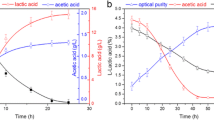Abstract
2,3,5,6-Tetramethylpyrazine (TTMP) was produced using a newly isolated Bacillus mutant. Culture medium optimization studies showed that soytone, an enzyme-hydrolysate of soybean meal, with the supplementation of vitamins, can fully replace yeast extract plus peptone in supporting TTMP production from glucose. In a 5-l fermenter, using the optimized medium which contained 20% glucose, 5% soytone, 3% (NH4)2HPO4, and vitamin supplements, fermentations were carried out with stirring at 700 rpm, air flow at 1.0 vvm, controlled pH at 7.0, and temperature at 37 °C. TTMP reached 4.33 g l−1 after 64.6 h cultivation. A product recovery method was described, which involved evaporation, crystallization, and lyophilization. The product purity was 99.88%, determined by GC with the normalization method. The main impurities were 2,3,5-trimethylpyrazine (0.09%) and 2-ethyl-3,5,6-trimethylpyrazine (0.02%), which were identified by GC/MS. 13C NMR determination also gave a consistent result. Natural and high purity of the product and the utilization of cheap green renewable materials make this process promising to compete with TTMP chemical synthetic methods.





Similar content being viewed by others
References
Amrani-Hemaimi M, Cerny C, Fay LB (1995) Mechanisms of formation of alkylpyrazines in the Maillard reaction. J Agric Food Chem 43:2818–2822
Besson I, Creuly C, Gros JB, Larroche C (1997) Pyrazine production by Bacillus subtilis in solid-state fermentation on soybeans. Appl Microbiol Biotechnol 47:489–495
Carlton BC, Brown BJ (1981) Gene mutation. In: Gerhardt P, Murray RGE, Costilow RN, Nester EW, Wood WA, Krieg NR, Phillips GB (eds) Manual of methods for general bacteriology. American Society for Microbiology, Washington District of Columbia, p 226
Chang, Clarence D, Perkins, Patrick D (1989) Process for making alkyl pyrazines. US Patent 4, 855, 431
Chang FC, Huang YT, Lin HC, Hong CY, Lin JG, Chen KJ (1999) Beneficial effects of combined terlipressin and tetramethylpyrazine administration on portal hypertensive rats. Can J Physiol Pharm 77:618–624
Guo SK, Chen KJ, Qian ZH, Weng WL, Qian MY (1983) Tetramethylpyrazine in the treatment of cardiovascular and cerebrovascular diseases. Planta Med 47:89
Hashim P, Selamat J, Ali A, Kharidah S (1997) Pyrazines formation in cocoa beans: changes during fermentation. J Food Sci Technol 34:483–487
Ho WK, Wen HL, Lee CM (1989) Tetramethylpyrazine for treatment of experimentally induced stroke in Mongolian gerbils. Stroke 20:96–99
Holt JG, Krieg NR, Sneath PHA, Staley JT, Williams ST (1994) Bergey’s manual of determinative bacteriology, 9th edn. Williams & Wilkins, Baltimore
Ito T, Sugawara E, Miyanohara JI, Sakurai Y, Odagiri S (1989) Effect of amino acids as nitrogen sources on microbiological formation of pyrazines. Nippon Shokuhin Kogyo Gakkaishi 36:762–764
Kosuge T, Zenda H, Tsuji K, Yamamoto T, Narita H (1971) Studies on flavor components of foodstuffs. Part 1. Distribution of tetramethylpyrazine in fermented foodstuffs. Agric Biol Chem 35:693–696
Krieg NR (1981) Enrichment and isolation. In: Gerhardt P, Murray RGE, Costilow RN, Nester EW, Wood WA, Krieg NR, Phillips GB (eds) Manual of methods for general bacteriology. American Society for Microbiology, Washington District of Columbia, pp 114–115
Kwon S, Lee PC, Lee EG, Chang YK, Chang N (2000) Production of lactic acid by Lactobacillus rhamnosus with vitamin-supplemented soybean hydrolysate. Enzyme Microb Technol 26:209–215
Larroche C, Besson I, Gros JB (1999) High pyrazine production by Bacillus subtilis in solid substrate fermentation on ground soybeans. Process Biochem 34:667–674
Lonc E, Lecadet MM, Lachowicz TM, Panek E (1997) Description of Bacillus thuringiensis wratislaviensis (H-47), a new serotype originating from Wroclaw (Poland), and other Bt soil isolates from the same area. Lett Appl Microbiol 24:467–473
Masuda H, Mihara S (1988) Olfactive properties of alkylpyrazines and 3-substituted 2-alkylpyrazines. J Agric Food Chem 36:584–587
Qi X, Ackermann C, Sun D, Sheng M, Hou H (2003) Physicochemical characterization and percutaneous delivery of 2,3,5,6-tetramethylpyrazine. Int J Pharm 253:177–183
Sato, Kanji (1978) Process for preparing pyrazines. US Patent 4,097,478
Seitz EW (1994) Fermentation production of pyrazines and terpenoids for flavors and fragrances. In: Gabelman A (ed) Bioprocess production of flavor, fragrance, and color ingredients. Wiley, New York, pp 95–134
Shoji, Takayuki, Nakaishi, Toru, Mikata, Masafumi (1997) Process for producing pyrazine compounds. US Patent 5,693,806
Sugawara E, Ito T, Yonekura Y, Sakurai Y, Odagiri S (1990) Effect of amino acids on microbiological pyrazine formation by B. natto in a chemically defined liquid medium. Nippon Shokuhin Kogyo Gakkaishi 37:520–523
Tsai TH, Liang CC (2001) Pharmacokinetics of tetramethylpyrazine in rat blood and brain using microdialysis. Int J Pharm 216:61–66
Watanabe H (1997) Candidates for cognitive enhancer extracted from medicinal plants: paeoniflorin and tetramethylpyrazine. Behav Brain Res 83:138–141
Weitz HM, Fischer RH (1977) Manufacture of pyrazines. US Patent 4,064,124
Yamaguchi N, Toda T, Teramoto T, Okuhira T, Sugawara E, Ito T (1993) Studies on pyrazine formation by Bacillus natto. V. Effect of sugars on microbiological pyrazine formation by Bacillus natto in synthetic liquid medium. Nippon Shokuhin Kogyo Gakkaishi 40:841–848
Zak DL, Ostovar K, Keeney PG (1972) Implication of Bacillus subtilis in the synthesis of tetramethylpyrazine during fermentation of cocoa beans. J Food Sci 37:967–968
Acknowledgements
The authors gratefully acknowledge the financial support of this work by Shanghai Apple Flavor & Fragrance Co., Ltd. (China) (SAFF). We are also grateful to Dr. J. Huang at SAFF for analytic assistance.
Author information
Authors and Affiliations
Corresponding author
Rights and permissions
About this article
Cite this article
Xiao, Z.J., Xie, N.Z., Liu, P.H. et al. Tetramethylpyrazine production from glucose by a newly isolated Bacillus mutant. Appl Microbiol Biotechnol 73, 512–518 (2006). https://doi.org/10.1007/s00253-006-0491-6
Received:
Revised:
Accepted:
Published:
Issue Date:
DOI: https://doi.org/10.1007/s00253-006-0491-6




